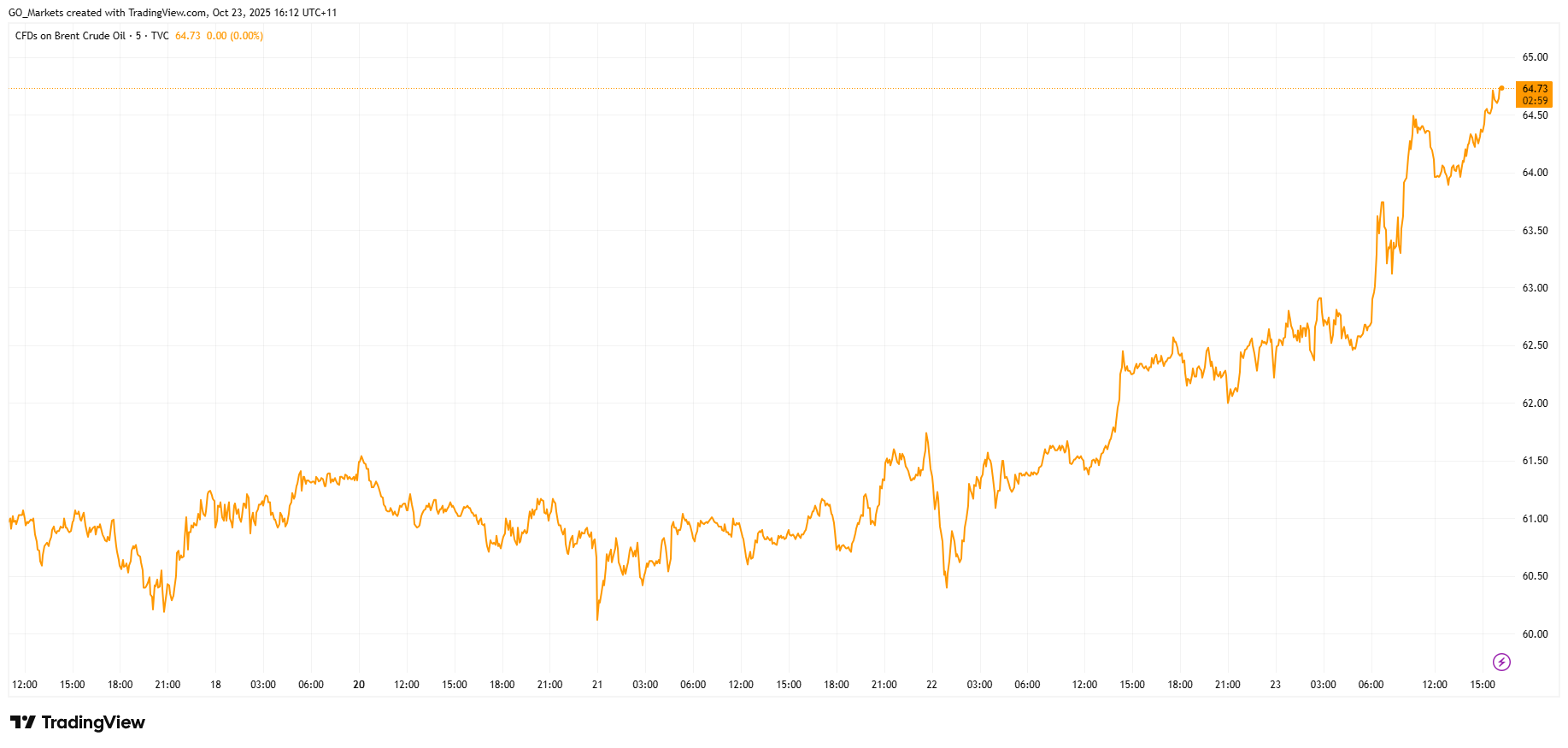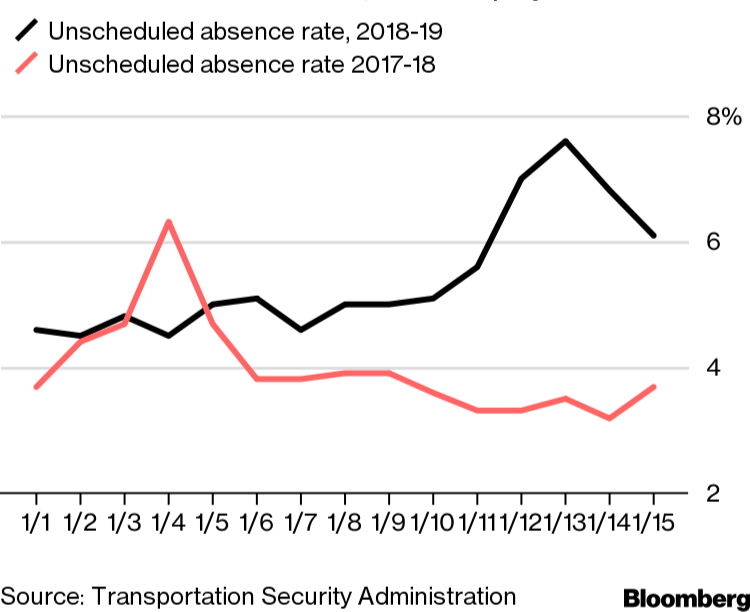市场资讯及洞察

New U.S. Sanctions on Russia as Putin Conducts Nuclear Tests
The U.S. has imposed new sanctions on Russia's two largest oil companies, Rosneft and Lukoil, after planned peace talks between Trump and Putin collapsed on Wednesday.
Oil prices spiked 3% after the announcement, with Brent crude hitting $64 per barrel.

The targeted companies are among the world's largest energy exporters, collectively shipping about three million barrels of oil daily and accounting for nearly half of Russian production.
The sanctions build on recent European measures, as the UK targeted the same companies last week and the EU approved its own sanctions package on Wednesday.
In a show of force coinciding with the new sanctions, Putin supervised strategic nuclear exercises on Wednesday involving intercontinental ballistic missile launches from land and submarine platforms.
While the Kremlin emphasised these were routine drills, the highly coincidental timing is notable.
For markets, the key question now is whether secondary sanctions will follow, and if Trump’s enforcement remains strict. Traders will watch closely for any TACO signals that see Trump ease pressure in an attempt to restart negotiations.
Historic PM Wasting No Time on Celebrations
Sanae Takaichi made history this week as Japan's first female Prime Minister. The 64-year-old conservative leader, dubbed the "Iron Lady,” is already rolling out an aggressive policy agenda that could reshape Japan's economic and geopolitical position.
Her first major move is an economic stimulus package expected to exceed US $92 billion. The package includes abolishing the provisional gasoline tax and raising the tax-free income threshold from ¥1.03 million ($6,800), moves designed to put more money in consumers' pockets and battle inflation.

Her next move will come when Trump arrives in Tokyo next week, as the Japanese government is finalising a purchase package including Ford F-150 pickup trucks, US soybeans, and liquefied natural gas as sweeteners for trade talks.
Takaichi has campaigned on being a champion for expansionary fiscal policy, monetary easing, and heavy government investment in strategic sectors, including AI, semiconductors, biotechnology, and defence.
Critical Workers to Miss First Paycheck Due to Shutdown
The U.S. government shutdown is on the verge of creating a crisis for aviation safety, with 60,000 workers set to miss their first full paycheck this week.
These essential workers, who earn an average of $40,000 annually, already saw shortened paychecks last week. By Thursday, many will receive pay stubs showing zero compensation for the coming period, forcing impossible choices between basic necessities and reporting to work.
During the last extended shutdown, TSA sick-call rates tripled by Day 31, causing major delays at checkpoints and reduced air traffic in major hubs like New York — disruptions which are directly attributed to pressuring the end of the previous shutdown.

The National Air Traffic Controllers Association warns that similar pressures are building, with many workers soon to be facing a decision between attending their shift or putting food on the table.


In this article, we take an in-depth look at the concept of strength of signal and its potential role in improving trading outcomes. Traders are constantly seeking ways to enhance their results consistently, and the idea of evaluating the strength of a trading signal may provide a pathway toward greater reliability and performance when applied to trading systems across multiple timeframes and instruments. By delving into this concept, we will explore not only what strength of signal means but also the key factors involved in its practical application in decision-making and trade execution.
Why Could Strength of Signal Be Important for Traders? Definition: Strength of signal refers to the degree of confidence and reliability a particular trading signal provides regarding anticipated market movements. It measures the quality and trustworthiness of a trading setup, aiming to increase the likelihood of success by filtering out weaker signals and focusing on higher-probability opportunities.
The idea of strength of signal is most commonly applied to trade entries, where traders seek to increase their chances of entering the market at an optimal point. This can lead to better overall performance by avoiding premature or low-confidence entries that could result in losing trades. However, strength of signal also holds significance in trade exits.
For instance, a strong signal at the entry point may weaken over time, indicating a lack of continuation in the trend. This change in signal strength could provide the trader with an early warning to exit the trade before a reversal occurs. At its most basic application, strength of signal may help traders decide whether to enter a trade.
However, its implications are far-reaching, influencing other critical aspects of trading such as: Position sizing: When the signal is stronger, a trader may feel more confident about increasing their position size. A weak signal, on the other hand, may prompt the trader to either reduce their position size or avoid entering the trade entirely. Accumulating positions: If a trader has already entered a trade and the strength of the signal improves, they might decide to add to the existing position.
This practice, known as scaling in, can maximize gains during favourable market conditions. Exit decisions: Weakening signal strength can serve as a warning sign to exit a position. If a trade was initially based on a strong signal but the factors driving that signal begin to diminish, it could indicate a shift in market sentiment, prompting the trader to take profits or cut losses.
Components of Strength of Signal The strength of a signal can be broken down into three broad categories: price action, trading volume, and the confluence of technical indicators. Each of these components contributes in its own way to the overall reliability of the trading signal. a. Price Action Price action is the cornerstone of technical analysis and is considered the most important component when assessing the strength of a signal.
This is because price action reflects real-time market sentiment and behaviour. Candle structure: The open, high, low, and close (OHLC) of a candlestick offers vital clues about the current battle between buyers and sellers. For example, long wicks might indicate rejection of certain price levels, while a series of bullish or bearish candles can point to the start of a trend.
Patterns and formations: Multiple candlesticks forming patterns (e.g., head and shoulders, triangles, or flags) can provide insight into potential reversals or continuations. Recognizing these patterns can significantly contribute to assessing signal strength. Timeframe comparison: Price action can vary significantly across different timeframes.
A signal that appears strong on a lower timeframe, such as a 5-minute chart, might weaken when compared to the price action on a daily or weekly chart. Evaluating the signal across multiple timeframes helps traders confirm its validity. Key levels: Price action near key levels, such as support and resistance or pivot levels, play a crucial role in signal strength.
The closer the market is to a critical level, the more likely a strong reaction will occur, either a bounce or a break, adding weight to the signal. b. Trading Volume Volume is another critical component of strength of signal, as it represents the number of shares, contracts, or lots being traded at a particular price. Volume provides insight into the level of market participation and the conviction behind price movements.
Volume confirmation: When volume increases in the direction of the price move, it signals strong market participation, adding confidence to the strength of the signal. A price movement without sufficient volume may be viewed with caution, as it could lack the momentum needed for continuation. Volume divergence: Divergence between price and volume can signal a weakening trend.
For instance, if prices are rising but volume is decreasing, it may indicate that the buying interest is waning, and the strength of the signal is diminishing. Volume spikes: Sudden spikes in volume can indicate institutional participation or a major market event. High-volume candles at key levels can often confirm the validity of a breakout or breakdown. c.
Other Indicator Confluence Technical indicators summarize historical price and volume data, and while they are lagging in nature, they are undoubtedly useful in adding an additional layer of confirmation to any signal evaluation. Commonly used indicators: Many traders rely on widely recognized indicators such as moving averages, RSI, MACD, or ATR. These indicators help identify trends, momentum, volatility, and potential reversals.
The alignment of multiple indicators—often referred to as confluence —can significantly strengthen a signal. Categories of indicators: Trend indicators: Tools such as moving averages and parabolic SAR can help traders identify the overall direction of the market. A trade that aligns with the prevailing trend is likely to have a stronger signal.
Momentum indicators: Indicators like RSI and MACD provide insight into the speed of the price movement. A weakening momentum might indicate that a trend is losing steam, reducing the signal’s strength. Volatility indicators: Tools like ATR measure the degree of price fluctuation.
Sudden changes in volatility can affect signal strength, as low volatility periods may precede explosive movements. Mean reversion indicators: Bollinger Bands and similar indicators help traders identify overbought or oversold conditions. Trades taken at the extremes of these indicators can have stronger signals if supported by price action and volume.
The Role of News and Events as an influence on strength of signal evaluation Event risk is a crucial, yet often underestimated, component of signal strength. No matter how strong a technical signal appears, the release of major economic data or geopolitical news can drastically alter market conditions, leading to unexpected price movements. It’s essential for traders to remain aware of scheduled news events, such as central bank meetings or earnings reports, which can cause sudden volatility.
A strong technical signal might be overridden by fundamental factors, so incorporating event risk into the overall assessment of signal strength is a necessary practice. The Case for Weighting and a Strength of Signal Score To make the assessment of signal strength more objective, traders can develop a weighted scoring system. By assigning a value to each component (price action, volume, indicators, etc.), they can generate a Strength of Signal (SOS) score.
This score provides a quantitative measure to guide trading decisions. Weighting components: Not all factors carry equal importance. For instance, price action may be assigned a higher weight than indicator confluence, as it reflects current sentiment.
A possible weighting system could look like this: Sentiment change: 40% Candle structure: 20% Higher timeframe confirmation: 10% Volume: 10% Proximity to key levels: 10% Momentum: 5% Volatility change: 5% Instrument and timeframe differentiation: Different instruments and timeframes may require tailored weighting. For example, the weighting system for a fast-moving 30-minute gold chart might differ significantly from that of a more stable 4-hour AUD/NZD chart. Using a Score to Drive Trading Decisions Once a strength of signal score is established, it can be applied to various aspects of trade management: Entry decisions: A minimum SOS score (e.g., 60) could be required for entering a trade.
This ensures that only high-quality setups are considered. Position sizing: A higher SOS score could justify increasing position size. For example, if the score is above 70, a trader might increase their position by 1.5x the normal size, while a score above 80 might warrant doubling the position.
Exit decisions: A decreasing SOS score (e.g., below 30) might signal the need to exit the trade, helping traders protect profits or minimize losses. Summary The concept of strength of signal offers a structured approach to assessing the quality of trading setups. By incorporating factors like price action, volume, and technical indicators into a weighted system, traders can make more informed decisions, potentially improving both their consistency and performance.
Experimenting with different scoring systems and analysing their impact on your trading strategy is worthwhile investigating further in the reality of your own trading. Over time, a well-developed score can provide valuable insights into when to enter, accumulate, or exit trades based on the changing dynamics of the market.


Introduction to Scaling in Trading Scaling in trading involves adjusting the size of trading positions based on specific criteria or rules. This concept is crucial for both discretionary and automated traders, with the latter group often finding it easier to implement due to the structured, rule-based nature of automated systems. For discretionary traders, scaling introduces flexibility to tailor position sizes to fit current market conditions or account balance.
Scaling strategies can apply to an entire account or to selected strategies, depending on the trader’s goals, approach, and the quality of their data. A well-planned scaling approach can enhance profit potential while managing risk, whereas an ad-hoc or uninformed scaling practice often introduces additional risks without promising substantial rewards. This article outlines critical concepts and principles in developing a robust scaling strategy, helping traders determine a path suited to their trading goals and risk tolerance.
Types of Scaling Approaches The choice of scaling approach is based on factors such as experience, trading objectives, and risk tolerance. Any structured scaling approach generally surpasses none, and selecting one today doesn’t preclude exploring others later. We’ll examine four common approaches to assist you in making an informed decision.
Fixed Lot Size Scaling Fixed Lot Size Scaling involves trading a consistent lot size for each position, regardless of changes in account balance or market conditions. This approach is straightforward and accessible, especially for beginners who might not be ready to adapt position sizes actively. However, fixed lot size scaling can be restrictive; it does not account for changes in account value or market dynamics, limiting the ability to manage risk effectively during volatile market periods.
Example in Automated Trading Fixed lot size scaling is especially useful when transitioning a model from backtesting to live trading. For example, if an Expert Advisor (EA) performed well during backtesting with a fixed lot size of 0.1, starting live trading at this minimum volume is prudent. Doing so allows traders to verify live performance against backtest expectations, ensuring the EA’s effectiveness in real market conditions before considering scaling up.
Fixed Fractional Scaling Fixed Fractional Scaling trades a set percentage of the account balance, automatically adjusting position sizes with account growth or shrinkage. This inherently responsive approach aligns with the account’s performance. For example, a trader may risk 1% of the account per trade in leveraged trading, calculating this amount based on the potential loss if a stop-loss is triggered.
This risk tolerance can vary depending on the individual’s strategy and objectives. Benefits and Considerations This approach helps manage risk, especially as the account size fluctuates. However, the varying lot sizes across different instruments and exposures require close monitoring.
For example, in a portfolio with both Forex and commodity trades, the risks associated with each asset type might differ. Traders must consider this variability to ensure their risk exposure remains consistent. Selective Strategy Scaling Selective Strategy Scaling increases position sizes based on the proven success of specific strategies or components within strategies.
This approach accelerates gains, but reaching a critical mass of trades to evaluate performance becomes more challenging due to its selective nature. Example of Strategy-Specific Scaling Consider a trader using multiple strategies: one focusing on trend-following and another on range-bound markets. If the trend-following strategy demonstrates a high win rate and favourable profit factor over time, the trader may selectively scale this strategy’s position sizes.
Meanwhile, the range-bound strategy could be scaled conservatively until it shows consistent performance. Selective scaling like this allows traders to leverage their most reliable strategies for greater potential returns. Variable Scaling (Advanced) Variable Scaling is a sophisticated approach adjusting trade sizes based on market conditions, including price action, trends, signal strength, and volatility.
Advanced traders using variable scaling develop a system to dynamically adjust position sizes based on indicators, providing flexibility to respond to market changes. Example Using Volatility Suppose a trader monitors market volatility through the Average True Range (ATR) indicator. In periods of low ATR (indicating low volatility), the trader might scale down positions to reduce risk.
Conversely, during high volatility, they might increase position sizes to capitalize on larger price swings. This approach requires a deep understanding of technical analysis and specific criteria for guiding scaling decisions. Broad Principles for Effective Scaling Effective scaling relies on well-defined criteria aligned with account size, risk tolerance, and trading performance.
Key metrics include account balance, margin usage, and trade success metrics. Incremental scaling allows traders to gradually adjust position size, thus managing risk as trading volume increases. A structured scaling plan ensures scaling decisions align with the trader’s goals and risk management rules, avoiding emotional, unplanned adjustments.
Optimal Conditions for Scaling (“The When”) Scaling should be guided by specific performance metrics that assess result reliability. Key indicators include: Win Rate: Consistency in win rate over time is crucial. A stable win rate suggests that the strategy performs well across various market conditions.
Profit Factor: A ratio of gross profit to gross loss. Generally, a profit factor above 1.5 indicates more profitable trades than losses. Drawdown: The peak-to-trough decline in account balance.
Lower drawdown suggests more stability, supporting the case for scaling. When combined with net profit and worked out as a ratio, with automated trading we would expect a Net profit to drawdown ration of at least 8:1 Risk-Reward Ratio: A higher ratio shows that profit potential outweighs losses, making the strategy more viable for scaling. Sharpe Ratio: This risk-adjusted return measure indicates better performance relative to risk.
For instance, if a trader maintains a high win rate, profit factor, and low drawdown, they might consider scaling up. However, if metrics vary significantly, scaling should be approached cautiously. Determining How to Scale The degree to which you scale is a crucial component of your plan.
Scaling is often done incrementally, such as moving from a starting lot size of 0.1 to 0.3, 0.5, and so on, based on the strength of results. For instance, a trader may scale up by 0.1 lot for each 5% account growth, provided performance metrics remain stable. It’s essential to clearly define this scaling plan before implementation, follow it precisely, and review it over time to ensure it meets trading objectives.
Psychology and Challenges of Scaling Scaling involves a psychological shift, as traders manage larger positions with increased potential profit and loss. Traders often encounter procrastination, impatience, or anxiety, especially when adjusting to larger numbers. Managing Psychological Challenges To illustrate this principle in an example, if a trader accustomed to $100 maximum profits scales to a position where potential profits reach $400, the temptation to close trades early may be overwhelming.
To ease this transition, a trader might simulate the larger trades in a “ghost account,” which mirrors live trading without risking real capital. This simulation allows the trader to become comfortable with the numbers, building confidence without financial exposure. Creating and Committing to a Scaling Plan An effective scaling plan is data-driven, with metrics and thresholds to guide scaling actions.
Regular reviews ensure the plan adapts to evolving market conditions and performance outcomes. Like all elements of a trading system, a scaling plan requires discipline, objectivity, and data-driven actions rather than emotional reactions. Summary Scaling is an advanced trading concept that, when applied correctly, can optimize profit potential while managing risk.
This guide outlined various scaling approaches—Fixed Lot Size, Fixed Fractional, Selective Strategy, and Variable Scaling—each with distinct applications depending on the trader’s experience, strategy, and market conditions. Fixed lot size scaling offers simplicity and is suitable for beginners or automated trading, while fixed fractional scaling aligns well with account growth or decline. Selective strategy scaling focuses on increasing successful strategies' position sizes, while variable scaling dynamically adjusts to market conditions, requiring deep technical knowledge.
The guide also emphasized key performance metrics for effective scaling and highlighted the psychological challenges involved, with strategies for managing emotional responses. Ultimately, a successful scaling plan is disciplined, data-driven, and regularly reviewed to ensure alignment with trading objectives. Traders who develop and commit to a structured scaling approach can enhance their trading results by making informed, calculated adjustments to position sizes based on performance metrics and risk tolerance.


Donald Trump's victory in the 2024 U.S. presidential election has already stirred financial markets, with various sectors and asset classes responding to anticipated policy shifts based on campaign promises. Whilst such promises often go unfulfilled, markets are beginning to price in these potential changes until clarity on policy directions emerges. In this article, immediate and potential market response will be explored, including the possible impact of specific asset classes.
Additionally, the “tariff issue” will be discussed, before finally shining the economic light locally, where the potential impact on Australia will be examined. Market responses across asset classes Let’s explore some of these specific asset classes with some discussion about the potential influence on each. 1. Stock Markets The post-election surge across all U.S. stock indices, saw Dow Jones Industrial Average.
Nasdaq and S&P500 hit record highs on the session subsequent to result confirmation. This reflects more than just optimism over deregulation and economic growth. The speed at which results cane across the wires and the potential threat of a repeat of the dramas of the 2020 post-election phase disappearing, gave certainty that is always preferred by market participants.
Of course, pre-election markets were already testing recent highs with some justification. Actual and anticipated interest rate cuts by Federal Reserve combined with satisfactory economic data, has led many to anticipate a "soft landing" scenario, so boosting investor confidence. This combined with better-than-expected corporate earnings in key sectors have provided the backbone for market resilience, along with the proliferation of AI (Artificial Intelligence) initiatives have all been contributory.
A definitive and early result has given rise to further moves higher. There are notable, more specific sector responses including: a. US Banking Sector: Large institutions like JPMorgan Chase, Wells Fargo, and Bank of America, are anticipated to benefit directly from Trump's policies.
With a promise of reduced banking regulations, investors are hopeful that banks will see increased lending flexibility and expanded profit margins, as higher interest rates tend to improve net interest margins (NIMs). The expectation of fewer regulatory barriers might also encourage more aggressive growth strategies within the sector. b. Energy Sector The anticipated shift back toward traditional energy sources aligns with the Trump administration’s “America First” energy policies.
The “drill baby drill” narrative (on arguably the back of significant monetary support for Trumps campaign from “big oil”) seemed to be popular with rally attendees and was one of the most common policy statements made. These policies could impact: Increased Fossil Fuel Production: Support for projects in drilling, fracking, and pipeline expansion could drive higher production levels in the US and so even less dependency on imports and an increase in export potential. Reduced Environmental Restrictions: The rollback of regulatory constraints on fossil fuel extraction may significantly lower compliance costs for companies in this sector.
Global Implications: Increased U.S. production could influence global oil prices, especially if OPEC countries adjust their own production to balance market supply. Renewable Energy Concerns: Decreased federal support may challenge the renewables sector’s growth, impacting not only domestic green companies but also potentially influencing global green investment trends, where the U.S. has previously been a major player. c. Electric Vehicle (EV) Market EV companies like Tesla may find reduced competition as tariffs on Chinese imports potentially limit the influx of lower-cost EVs from China.
Potential policy changes could involve: Increased Import Tariffs: These would raise the cost of imported EVs and components, possibly giving U.S. manufacturers a competitive edge. Subsidy Rollbacks: Federal incentives for EV adoption may be scaled back, potentially slowing the sector's growth in the U.S. Elon Musk Factor: The relationship between Trump and Elon Musk, who has previously consulted with the administration, may offer Tesla unique opportunities or at least reduce regulatory barriers. 2.
Cryptocurrencies Bitcoin’s recent high of over $75,000 marks a substantial increase in value, attributed to market beliefs that the Trump administration may adopt a more lenient stance on cryptocurrency regulation. There is the potential for policies that may result in reduced government oversight, making the U.S. more attractive to crypto investors and blockchain technology developers. Should there be the expected inflationary pressures, growing adoption of Bitcoin as a hedge against inflation and economic uncertainty may also pushing its price even higher still. 3.
Bond Markets Bond markets are pricing in potential inflationary pressures, especially if fiscal policies like tax cuts, infrastructure spending, and defense investment are actioned. The surge in Treasury yields suggests again an anticipation of increased inflationary pressure as a result of some policies notably the tariffs that formed a significant part of proposed economic policy in the next Trump administration. 4. Currency Markets The U.S. dollar has strengthened against other major currencies due to higher interest rate expectations.
A stronger dollar has complex implications: International Trade Impact: A strong dollar could make U.S. exports more expensive for foreign buyers, potentially affecting the profitability of U.S. exporters and the trade balance. Global Financial Stability: Many international debts are denominated in U.S. dollars. A stronger dollar can increase repayment costs for countries with dollar-denominated debts, possibly leading to financial strain in emerging markets. 5.
Impact on Commodity Markets a. Gold: Often viewed as a safe-haven asset, gold prices initially dropped with the dollar's strength but could see a resurgence if inflation fears grow. Persistent inflation concerns often prompt a flight to gold, which investors regard as a hedge against declining purchasing power. b.
Oil: U.S. policy supporting fossil fuel production may create downward pressure on oil prices in the long term if supply significantly increases. However, geopolitical factors and OPEC’s production policies will also play key roles. c. Copper: Copper is integral to renewable energy infrastructure, especially in wind turbines and solar panels.
Reduced enthusiasm for renewables under the new administration could dampen copper demand, impacting both prices and the supply chains of green technologies. The potential impact of Tariffs The use of tariffs has been a central part of the Trump campaign and although beyond the hype (and misunderstanding) of what this will actually look like in reality, widespread implementation WILL impact potentially in some key areas. Overall, the consensus appears to be is that buyers—primarily U.S. consumers and businesses—will bear the majority of the cost of tariffs.
Here’s a breakdown of how this works and how these may impact in practice: 1. Direct Cost on Imports: When a tariff is imposed, it acts as a tax on imported goods. The seller may attempt to absorb some of this cost to stay competitive, but often they pass at least part of it on to the buyer through higher prices. 2.
Impact on Consumers: For consumer goods, this means that U.S. consumers typically see increased prices, as companies raise their retail prices to cover the added tariff cost. For example, tariffs on electronics, furniture, or clothing often lead to direct price increases in stores. Estimates indicate that these tariffs could cost typical American households an additional $2,600-$4000 annually. 3.
Impact on Businesses: Many manufacturers rely on imported components, especially in the technology, automotive, and retail sectors are likely to see impact. U.S. businesses that rely on imports may face higher costs, which they then pass along in the form of higher prices for finished goods or services. 4. Limited Absorption by Sellers: Foreign exporters might absorb part of the tariff to maintain their U.S. market share, but most economists agree this effect is often limited.
In practice, many sellers have limited ability to lower prices and instead adjust their sales strategies or explore other markets. 5. Impact on economic growth: Analyses suggest that implementing a 10% across-the-board tariff on all U.S. imports could reduce long-term GDP by 0.2% and result in the loss of approximately 142,000 full-time equivalent jobs. 6. Global Trade Relations: Theoretically, imposing high tariffs could provoke retaliatory measures from trading partners, potentially leading to trade wars.
This escalation may disrupt global supply chains and hinder international trade, adversely affecting both U.S. and global economic stability. BUT is there positive potential for tariffs ? Some argue, and indeed has been at the basis of much of the Trump pre-election push, that tariffs could incentivise US domestic production and protect American jobs by making imported goods more expensive relative to domestically produced items.
As previously referenced, EV’s are a good example of this Implications for Australia Australia could experience significant ripple effects from Trump’s policies. Although the severity of any impact may take some time to unfold, and is difficult to project in detail until we see the reality of policy implementation. However, there are some areas worth watching over the coming months.
This include: 1. Economic Impact: With China as Australia's largest trading partner, any tariffs the U.S. imposes on Chinese goods could indirectly harm Australian exports, especially in minerals and agricultural goods. As such an important part of the Australian economy, downwards pressure on the materials sector performance could have wide-reaching effects on Australian economic health as a whole, far beyond the direct impact on miners directly. 2.
Investment Climate: Policy shifts in the U.S. could lead to increased market volatility, which may make Australian investors wary. An unstable investment climate could also affect foreign investment inflows to Australia. 3. Australia-U.S.
Trade: Australia may seek to bolster its trade agreements with the U.S., Generally, Trump favours bilateral agreements rather than multilateral, which could benefit certain Australian exports. 4. Security and Defense a. U.S.
Alliance Review: Trump’s scepticism toward NATO and other security alliances could influence the U.S.-Australia security relationship, especially in terms of cost-sharing. b. AUKUS Partnership and the Indo-Pacific: As a crucial partner in the Indo-Pacific, Australia may see increased expectations from the U.S. to take on a more active role in regional security, especially regarding China. This may require heightened defense commitments and could influence the allocation of Australian resources into the defense sector.. 5.
Climate Policy Australia’s climate policies could be influenced if the U.S. steps back from international environmental agreements. Trump’s previous withdrawal from the Paris Agreement had notable implications, and the expected pullback in US commitment to global initiatives going forward may produce pressure on Australia’s climate commitments. Any U.S. retreat from international climate accords could slow global progress, impacting industries and investor sentiment around sustainable practices.
Summary Trump's victory in the 2024 election represents a pivotal moment that will arguably redefine the U.S. and Australian financial markets, as well as broader economic and geopolitical landscapes. Whilst exact policy directions and timing are not likely to be clarified for some time, both traders and investors should prepare for market volatility. The real impact of these policy shifts will unfold in time, highlighting the need for vigilance and adaptability in response to evolving conditions.
Of course, GO Markets are here to help with regular market updates including articles, videos and webinars to help you negotiate your way through such challenges.


Australia's second quarter CPI due out on the 31st of July could go one of two ways so let's dive into how it will move and how to trade it. First way - Coming in line or below Currently 24 of the 30 surveyed economists see inflation coming in line or below expectations. That is June quarter CPI coming in at 1% quarter on quarter and 3.8% year on year.
Trimmed mean expected to come in at 0.9 of 1% quarter on quarter and 4% year on year remembering this is the preferred measure of the RBA. If this is indeed the case it would mean a step down from the March quarter read which was 1% and would hold year on year inflation at 4%. We need to highlight the RBA own forecast as well, because at the last Statement of Monetary Policy update the forecasted head inflation was the same as the consensus 3.8% year on year.
But trimmed mean inflation is 0.2% lower at 3.8% year on year. This will be interesting because the Hawks out there believe anything that is 3.9 or above will be a trigger for the RBA next Tuesday. The variance can be put down to several things how the trimming is actually done but what really matters to us as traders is the impact of dwelling and rents on the inflation figure which has been a key factor for inflation overshooting over the last two years.
If we have a look at rent, expectation is for a 1.9% June quarter rise down from 2.1% in the March quarter. So trending in the right direction but still well above a comfortable and sustainable level. Rent’s overall contribution to the full figure at this point is 0.12 compared to house purchases which is only 0.08 the expectation for the June quarter is 1% the house purchases have 1.9% for utilities.
This gives a combined figure of 1.35% for the June quarter in housing. It is the number one thing to watch on Wednesday. Health is the other part of the inflation data to watch.
We've not got any major updates in the monthly CPI data about health and the expectation is for the June quarter to see a 2.5% increase in health inflation. This is the other part of the data that will matter. We highlight all this to give you as much information as possible to make informed decisions at the 11:30 Australian Eastern Standard Time drop.
Because if the data does come in at these levels it will probably be enough to confirm the RBA will hold at their August 6 meeting. And in line or below figure is likely met with dovish views and bearish trading. More on that below.
Second way: Above expectations What's so interesting about Wednesday's CPI is that for the last 6 consecutive quarterly updates Australia CPI has not just come in above consensus it has been above the full range of views. It's why its giving us reason to pause and to suggest that there is every chance based on the data from the monthly inflation figures the upside surprise is a very real possibility. Retail spending although sluggish has remained above expectations, services have seen reasonable price increases during the April to June.
As things like insurance, telecommunications and utilities increase prices well and truly above the inflation rate. Education already expected to be strong has also seen wage increases during this quarter along with higher infrastructure spending from state governments. Housing which is already forecasted to be strong has surprised to the upside in every one of those six previous readings and according to Core Logic and Prop Track data of the April to June figures suggests that it could be a seventh time in a row housing comes in above expectations.
The final unknown is the energy rebates. It's been so surprising just how long injury baits have been able to hold down electricity prices in the CPI. Several forecasts now show the snapback from these rebates is on.
If this transpires, the expectation is for energy to snap 7.2% higher in the June quarter. Now the caveat here is that already the federal government has put a new $300 per household energy rebate policy in place so maybe this will be ignored. But there's no getting away from the fact energy is the big unknown and one that could blow the CPI data well above expectations.
This is likely to see bullish bets being made on the August 6 RBA meeting and strong positioning in the Aussie dollar. We think at the moment this outcome is being discounted by the market and by the economic world. Because the question that needs to be asked can the RBA justify inflation now running above its own target for three years in a row?
We would argue it probably can't. What trade First and foremost, we need to warn against looking at AUDJPY and AUDUSD. The reason for this, do not forget pretty much at the same time as Australia’s CPI is being released the Bank of Japan is forecasted, for the first time in decades, to release it artificially depressed interest rates.
We know that the BoJ has been defending the JPY over the past month and having seen the AUDJPY get to as high as ¥109.5 in early July the cross now sits at parity. If the BoJ does do as forecasted the cross could do anything on Wednesday. Then there is the unknown about how traders will position with all the machinations the BoJ action and the CPI data means – realistically the cross could experience some mass volatility.
The other is that it is the beginning of the US Federal Reserve’s July meeting and although there is no expectation that they will cut rates on Thursday, it is unknown what would be said during chairperson Powell’s press conference. FX safety trade has been pretty solid over the last period and money has flowed back to the USD. We are unsure about what could happen over the 48 hours between the CPI and when the Fed reports for that reason, we think the USD is probably not the one to look at for this particular piece of data trade.
Thus crosses such as EURAUD, AUDNZD and even AUDCAD are probably better options if you are going to trade pre and post the CPI data as there is no major impact on the other side of the cross from fundamentals in the next 72 hour period. If you are looking to the August 6 RBA meeting you can look at AUDUSD and AUDJPY but with entry points late on Thursday or Friday when there will be a greater understanding about what the Bank of Japan and the US Federal Reserve have done and will do in the future. Happy trading


We now have a post-Jackson Hole set of questions – will the data stick up to what was preached. Reviewing the reactions to Jackson Hole treasury yields declined on a ramp up in bets around the Federal Funds rate after Federal Reserve Chair Jerome Powell's dovish remarks, which were in line with what we forecasted last week. His dovish remarks were enough to shift market expectations for the September Federal Open Market Committee (FOMC) meeting not just towards a potential rate cut, but to a possible heavier cut (50 basis points or more).
Current market pricing for September is above 30 basis points suggesting it is keeping some of its powder dry ahead of the mid-September meeting. But it wasn’t the absolute nail in the hawkish view some were hoping. The current economic environment is making markets highly reactive.
Every piece of data that could indicate whether the U.S. economy is heading for a "hard" or "soft" landing is being scrutinised. That is particularly evident post the softer employment data released in early August, and thus we traders still have plenty of volatility to play with in the coming weeks. Jackson Hole in review Chair Powell's remarks at Jackson Hole signalled the shift in the Fed's focus we all expected.
But it is where the focus has shifted to that matters – the Board’s focus has shifted from inflation to labour market concerns. He emphasised that the Fed does not seek further cooling in labour market conditions and noted that the labour market is looser now than it was in 2019 when inflation was below 2%. While Powell did not specify the size of potential rate cuts, he indicated that the current policy rate gives the Fed ample room to respond to any risks, suggesting that rates are still far from neutral and could return to that level relatively quickly.
The market has taken this change in focus to pencil in the next most important date into its calendar – September 6. This is when the August employment data will be released, and it will be crucial in determining whether the Fed opts for a 25 basis point or a 50 basis point rate cut 10 or so days later. If the unemployment rate remains at 4.3% or rises further, comments suggesting that the labour market is “strong” would appear to be out of touch, and language like this sounds eerily similar to the previous underestimation of inflation being "transitory." So lets drill into what will be the biggest driver of FX and indices ahead of the September meeting - labour The Labour Market the Key to all In the coming weeks, the most critical economic data will revolve around the labour market, as its health will determine whether consumer spending and overall economic activity has remained strong.
The Bureau of Labor Statistics recently estimated that payroll employment as of March 2024 is 818,000 lower than initially thought. Think about that for one second, that is the entire population of the Gold Coast and 80,000 more or to put into Australian numbers its 60,000 jobs less than originally suggested. This has moved the average monthly figure down by 68,000 jobs for the period from April 2023 to March 2024 going from 247,000 a month to 179,000 a month.
The Fed needs to average 200,000 for the economy to be running at neutral. Although these revisions are not finalised until February 2025, the significance is clear - the jobs market is not as strong as previously believed and suggests like we discussed last week that the US could be skidding into a recession based on the Sahms recession indicator. Which is when the three-month moving average of the national unemployment rate is 0.5 percentage point or more above its low over the prior twelve months.
This was triggered in early August and we saw what that led to. What has also caught traders off guard is that historically, revisions to payrolls have been to the upside versus preliminary estimates, mainly due to delays in receiving more complete data from the Quarterly Census of Employment and Wages (QCEW). But when we look at periods of economic stress, take 2009 for example, the final estimates have sometimes shown even larger downward revisions than what we have seen this year.
This trend might be due to the overestimation of factors like the birth-death adjustment and part-time to full-time payrolls, which could be happening again now. If 2024 estimates are indeed overstated, it suggests that July's job growth was more likely to be 114,000 jobs, a figure that may not be confirmed until the next year's benchmark revisions. But a massive USD risk whatever the final figure turns out to be.
We stated last week that despite USD dovish trading over the past few weeks. It’s far from overdone. And we see the labour force data for the rest of the year being key to possible further selling Divergence Between Payroll Growth and Unemployment That brings us to the growing divergence between strong payroll job growth and rising unemployment.
We need to point out here this is not just a US phenomenon, Australia is seeing this situation as well, and it’s to do with the participation rate which is sneaking up. This means more people are falling back into the employment surveys suggesting unemployment might be higher than reported. So despite the robust employment growth figures – unemployment is on the rise faster than growth.
Housing Market Switching to the other great indicator for the Fed and FX traders alike – housing. Existing home sales rose modestly in July, yet new home sales increased at a surprisingly strong pace – however thankfully they remain within recent ranges. Despite a recent decline in mortgage rates (see the 30-year rates as the benchmark here), there has been no significant uptick in new demand, with mortgage applications for purchases remaining low and higher-frequency sales indicators still soft.
Although not on the same level as the labour market for FX movements, signs of overconfidence, increased mortgage applications and existing home sales spikes would get the FOMC’s hawks crowing again. These members have suggested that there hasn’t been sufficient housing stress yet to signal a hard sustained cutting cycle is imminent making housing data the contrarian trade indicator. The conclusion We retain the view that the USD is facing continued head winds, labour data is weakening, the economy is slowing to levels that suggest it could be flirting with recession and inflation is back in sight of the 2% handle.
There is also one other piece of information that allows us to retain our bearish view on the USD… Don’t Fight the Fed! – if they want to cut, they will take the USD with it.


Jackson Hole Symposium – When doves try Market pricing of the Federal Funds rate currently sits at 93 basis point of easing by year-end. Let us put that into perspective it was 110 basis points of easing at the peak of excitement, yet despite the increase in yields DXY has sold off and now trades sub-102.00 and is still falling like a stone. Why?
It's not like EUR/USD data from Europe is smashing USD bulls, European PMIs are expected to be around 50.1, a barely expanding outlook. So it's not that. Second point some are highlighting is the rise and rise of Vice President Harris.
The odds of her taking the Oval Office are mounting by the day. On the day it was announced she will be Democrats presumptive nominee her odds of winning according to Predictit.org was 45c now: She is odds on. Which has put her policies front and centre, including her latest announcement of possible increase to the corporate tax rate to as high as 28 percent.
That might explain DXY’s fall. But really it looks to be down to the only event that has mattered all year – when is the Fed going to cut rates? The off again on again nature of where the Fed sits has been down to the surprise rally in inflation in the March quarter and this has led to Board dissent, mis-matching communication and a general rudderless trading in bonds, FX and like as Powell and Co. faffed about.
That appears like its going to end this week as we turn our attention to Wyoming and the annual Jackson Hole Monetary Policy Symposium. Everything is gearing up to a Jerome Powell speech that will finally set the ship on a clearer path. Why do we think this?
Because history shows that Jackson Hole is normally when Fed Central Banks lay out their playbooks for the coming period. For example: In 2010 as the world and the US struggled to break out of the slump created by the Global Financial Crisis then-Fed Chair Ben Bernanke hinted (practically mapped out) the second series of Quantitative Easing, the bond-buying program designed to stimulate growth and maintain price stability. The markets responded fervently to the money taps being opened further, and the bulls that were long made a killing.
Then in 2020 Now-Fed Chair Jerome Powell announced a major shift in Fed policy framework, introducing average inflation targeting rather than the hard and fast figure of the previous generations. This meant the Fed would now be able to tolerate price fluctuations and periods of time where inflation might hold above the traditional 2% target before raising interest rates. This was in response to COVID and having the ability to flex policy due to the unforeseen nature COVID was creating.
In 2024 – will August 23 be another point for the history books? The doves certainly think so. Expectations are he will map out what the board is willing to tolerate around inflation as recent economic data points are a mixed bag which include: An easing Inflation rate, with July’s consumer price index falling below 3 per cent for the first time since 2021 but at 2.8 percent is still well off target and is falling at a slower pace than forecasted.
Consumer spending remains strong despite the first rate rise in the Federal Funds rate taking place over 20 months ago. July’s retail sales report showed a 1 per cent increase, well above expectations. Then there is the labour market, which was the cause of the recent market volatility due to what is known as Sahm’s recession indicator.
US non farm payrolls in the month of July came in at 4.4 percent - this is low by historical standards but it's the speed of change that triggered the Sahms recession indicator. Since 1950 every time the three-month moving average of the unemployment rate has risen by more than 0.5 percent from the previous 12 month low, The US has entered a recession. That's what is so telling for the market and why the doves are really trying to push The US dollar lower.
Powell is clearly facing a race against time in catching the economy and the unemployment rate before the handbrake in higher interest rates, which has been doing its job, stops working and causes the US to skid and crash. With all this as his “data dependent” input, Powell's remarks will be closely watched for further confirmation of an anticipated interest rate cut that is expected in September. As mentioned above the market has 93 basis points come year end.
With only three more meetings before the end of the year – one of the meetings could have a double notch cut associated with it. Will it be September? That is where Jackson hole comes in for the following reasons: A 25-basis-point cut may not be sufficient to prevent the economy from slipping into a recession, as higher rates make it more challenging for businesses to borrow and grow.
A 50-basis-point cut, on the other hand, risks reigniting inflation and sparking another speculative bull run in the markets, as cheaper borrowing costs could lead to increased risk-taking. Jackson Hole gives Powell the ability to test out the market’s appetite and concern, on this last point. If the response to a 50-basis point cut leads to speculative trading, and inflation fears before the September meeting then it will likely take the softer path.
If however the markets suggest this isn’t enough to ‘stop the skid’ then come December the 93 plus basis point cuts forecasted are on. Which brings us to the final point. Is the USD oversold?
In short – no. Yes, bearish beats are growing but looking at the likes of the EUR/USD, AUD/USD, GBP/USD and USD/CAD none of these are screaming oversold. In fact there is clear room for further runs particularly in the first two.
So set your alarm clocks – Jackson Hole is going to provide the playbook for the rest of the FX year.

